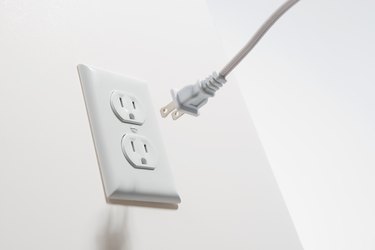
If you like to take your laptop on the road, you're probably aware that the sockets in some of your favorite internet cafes have seen better days. You plug in the heavy transformer that powers your laptop and the plug falls out of the outlet. The outlet won't hold the plug because springs that bind the prongs are worn out and no longer do their job. If this happens at home, the best way to handle the problem is to replace the loose receptacle, but you can't do that when you're on the road. However, there are a couple of tricks you can use to get laptop charged and get you back on social media.
It's Not Just About Inconvenience
Video of the Day
It's frustrating to wake up in the morning and find that the plug for your electric alarm clock has fallen out and you're now late for work. That isn't the most serious problem with an outlet that won't hold a plug, though. In many cases, the plug falls out only part-way. It's still connected to power, but the prongs are exposed, and a curtain could get caught on them. Add a little moisture and you've got a shock or fire hazard.
Video of the Day
Another problem with loose outlets is electric arcing. When you insert or remove a plug, the prong doesn't quite touch the receptacle socket and electricity jumps across the gap, producing a spark. This can also happen when a plug fits loosely and falls part of the way out of a receptacle. If the arcing goes on for more than a second or two, it can melt the receptacle and even start a fire.
If the Receptacle Is at Home, Replace It
You can't disassemble a receptacle to fix the springs – and even if you could, there would be no point in it. New receptacles are inexpensive and easy to replace. Just be sure to turn off the breaker controlling the circuit before you do this job.
Unscrew the cover plate, then unscrew the old outlet and remove the wires from the terminals. If more than one set of wires are connected, remember which ones are connected to each terminal or, better yet, take a picture of the arrangement with your mobile device. If you forget, remember the color code: Black wires go on brass terminals, white wires go on chrome ones and bare ground wires go on green ones. If the outlet is a GFCI or AFCI, the incoming line wires must be attached to the line terminals and the outgoing load wires must be attached to the load terminals. But for a conventional outlet, the wire orientation doesn't matter as long as you remember the color code.
Be sure to cap all unused wires in the box and that no bare wires are in contact when you replace the outlet and screw it back to the box.
Dealing with Loose Outlets When You're Not at Home
Two simple tricks can keep you powered up at your local internet cafe. One is to squeeze together the prongs of your power cord before inserting it. Don't be too aggressive or you could break the plug. You only need to move the ends of the prongs a millimeter or two closer to each other for the plug to grip.
The socket saver is another remedy for loose outlets. It's a handy plastic sleeve that fits inside the receptacle. Push one of these into the problem receptacle, plug in your cord and the cord will stay put. You can buy these handy implements online or at any hardware store. They usually come in multipacks, which cost less than $10.